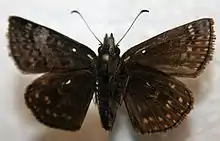Erynnis brizo
Erynnis brizo, the sleepy duskywing or banded oak duskywing, is a species of Hesperiidae butterfly that occurs throughout North America and is commonly confused with E. juvenalis and E. lucilius.[3] The species is listed as threatened in Connecticut and Maine.[4]
| Erynnis brizo | |
|---|---|
 | |
| Scientific classification | |
| Domain: | Eukaryota |
| Kingdom: | Animalia |
| Phylum: | Arthropoda |
| Class: | Insecta |
| Order: | Lepidoptera |
| Family: | Hesperiidae |
| Genus: | Erynnis |
| Species: | E. brizo |
| Binomial name | |
| Erynnis brizo | |
Description
The upper forewing is blackish brown with continuous bluish-brown spots. The hindwing is almost completely brown with lighter brown spots. The caterpillar of this species is small and gray green with purplish tips. There is a faint lateral white stripe. Unlike most caterpillars Hesperiidae have distinct heads and the E. brizo's head is brown with an orange spot.[5]
Habitat
This small Erynnis stays in oak-pine barrens and cut-over forest. It can be seen near forest edges including near roads, train tracks and towns.
Food plants
The larvae consume Scrub oak (Quercus ilicifolia) and other shrubby oaks. The adults consume Nectar from flowers of heaths (Ericaceae) including wild azalea and blueberry; also blackberry and dandelion.[6]

References
- "NatureServe Explorer 2.0 Erynnis brizo Sleepy Duskywing". explorer.natureserve.org. Retrieved 29 September 2020.
- "Erynnis brizo Boisduval & Le Conte 1832 - Encyclopedia of Life". Retrieved 2009-06-11.
- "Species Erynnis brizo - Sleepy Duskywing - BugGuide". Retrieved 2009-06-11.
- "Connecticut's Endangered, Threatened and Special Concern Species 2015". State of Connecticut Department of Energy and Environmental Protection Bureau of Natural Resources. Retrieved 19 January 2018.
- Nielsen, Mogens C. (1999). "Skippers". Michigan Butterflies & Skippers A Field Guide and Reference (1st ed.). Michigan State University Extension. pp. 184–185. ISBN 1-56525-012-5.
- "Sleepy Duskywing Erynnis brizo (Boisduval & Leconte, [1837]) | Butterflies and Moths of North America".
